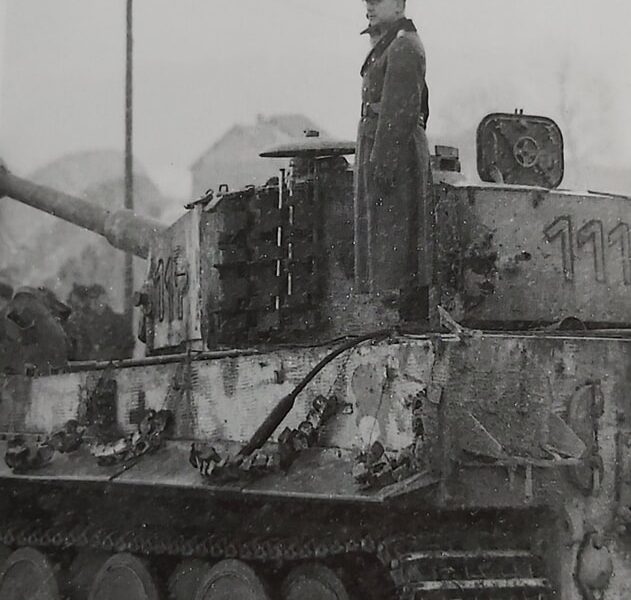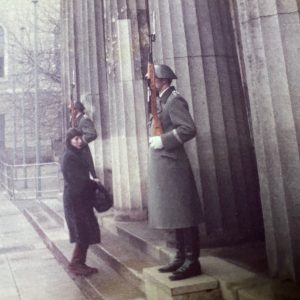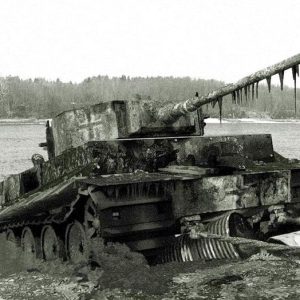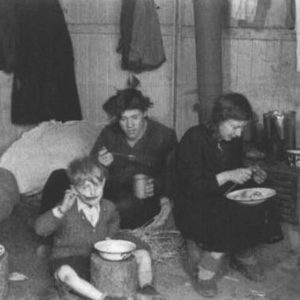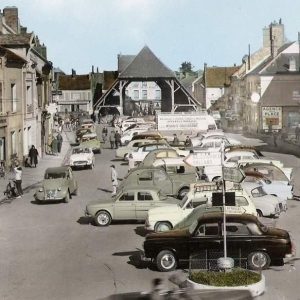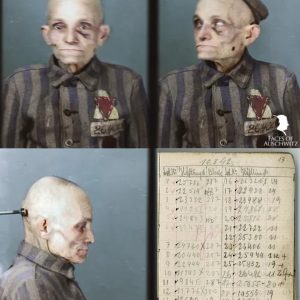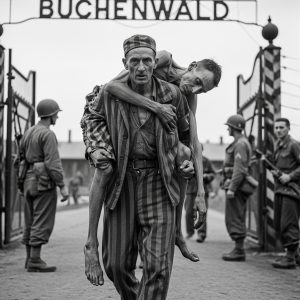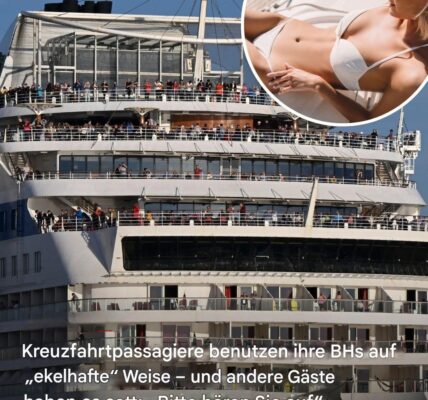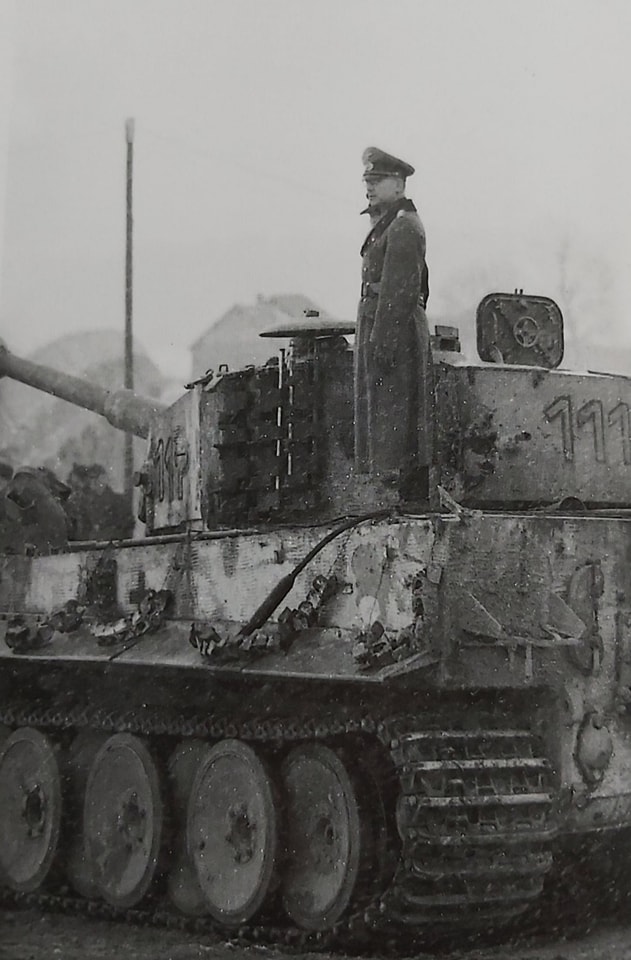
The Tiger I was a German heavy tank of World War II, used in Africa and Europe from 1942 onward, mostly in independent heavy tank battalions. Its final designation was Panzerkampfwagen VI Tiger Ausf. E, often abbreviated to Tiger . With the Tiger I, the Wehrmacht had its first armored fighting vehicle armed with the 3688 mm KwK gun (not to be confused with the 8.8 cm Flak 36). Only 1,347 examples were built between August 1942 and August 1944. Production was discontinued in favor of the Tiger II.
Although considered an outstanding design for its time, the Tiger I was overengineered, using expensive materials and labor-intensive production methods. The Tiger was prone to certain types of track breakage and breakdowns, and its high fuel consumption meant it had a limited range. It was expensive to maintain but generally mechanically reliable. It was also difficult to transport and prone to stalling when mud, ice, and snow froze between its overlapping and intermeshing box-tracked wheels , often jamming them. This was a problem on the Eastern Front in the muddy, rasputitsa and winter weather conditions.
The tank received its nickname “Tiger” from Ferdinand Porsche, and the Roman numeral was added after the later Tiger II entered production. Its original designation was Panzerkampfwagen VI Ausführung H (abbreviated PzKpfw VI Ausf. H), with “ H” standing for Henschel as the designer/manufacturer. It was classified with the weapons inventory designation SdKfz 182. In March 1943, the tank was renamed PzKpfw VI Ausf. E with the weapons inventory designation SdKfz 181 .
Today, only a few Tigers remain in museums and exhibitions worldwide. The Tiger 131 at the Bovington Tank Museum is currently the only one in working order.
Design history
Previous designs
Henschel & Sohn began developing a large tank in January 1937 when the Waffenamt commissioned Henschel to develop a breakthrough vehicle in the 30- to 33-ton range. Only a prototype of the hull was built, and it was never equipped with a turret. The shape and suspension of the breakthrough vehicle I resembled the Panzer III, while the turret resembled the early Panzer IV C turret with the short-barreled 7.5 cm L/24 cannon.
Before the Durchbruchwagen I was completed, a heavier, 30-ton-class vehicle with thicker armor was requested; this was the Durchbruchwagen II, which would have had 50 mm (2 in) frontal armor and a Panzer IV turret with a short-barreled 7.5 cm L/24 gun. The total weight would have been 36 tons. Only one hull was built and no turret was mounted. Further development of the Durchbruchwagen was discontinued in 1938 in favor of the larger and better armored VK 30.01 (H) and VK 36.01 (H) models. Both the Durchbruchwagen I and Durchbruchwagen II prototypes were used as test vehicles until 1941.
Another attempt
The designs of the medium tank VK 30.01 (H) and the heavy tank VK 36.01 (H) pioneered the Schachtellaufwerk , the overlapping and intermeshing main road wheels for tank use. This concept was already common on German half-tracks such as the Sd.Kfz. 7. The VK 30.01 (H) was to carry a slow 7.5 cm L/24 infantry support gun, a 7.5 cm L/40 dual-purpose anti-tank gun, or a 10.5 cm L/28 field gun in a Krupp turret. The total weight was to be 33 tons. The armor was to be 50 mm thick at the front and 30 mm on the sides. Four hull prototypes were completed for testing. Two of them were later modified to build the self-propelled anti-tank gun “Sturer Emil” (12.8 cm self-propelled gun L/61).
The VK 36.01 (H) was to weigh 40 tons and have 100 mm (4 in) of armor on the frontal surfaces, 80 mm on the turret sides, and 60 mm on the hull sides. The VK 36.01 (H) was to mount a 7.5 cm L/24 or a 7.5 cm L/43 or a 7.5 cm L/70 or a 12.8 cm L/28 gun in a Krupp turret resembling an enlarged Panzer IVC turret. The hull for one prototype was built, with five more following later. The six turrets built were never installed and were used as part of the Atlantic Wall. The VK 36.01 (H) project was canceled in early 1942 in favor of the VK 45.01 project.
Further improvements

The Porsche prototype
The combat experience against the French Somua S35 cavalry tank and the Char B1 heavy tank, as well as the British Matilda II infantry tanks during the Battle of France in June 1940, showed that the German army needed better armed and armored tanks.
On May 26, 1941, Henschel and Ferdinand Porsche were asked to submit designs for a 45-ton tank, to be completed by June 1942. Porsche was working on an updated version of his VK 30.01 (P) Leopard tank prototype, while Henschel was working on an improved VK 36.01 (H). Henschel built two prototypes: a VK 45.01 (H) H1 with an 88 mm L/56 gun and a VK 45.01 (H) H2 with a 75 mm L/70 gun.
Final drafts
On June 22, 1941, Germany launched Operation Barbarossa, the invasion of the Soviet Union. The Germans were shocked when they encountered Soviet T-34 medium-range tanks and the KV-1 heavy tank. Henschel designer Erwin Aders reported: “The dismay was great when it became apparent that the Soviet tanks were superior to all of the army fleet.” The T-34 was immune to almost all German guns head-on, except for the 8.8 mm anti-aircraft gun. Panzer IIIs with the 5 cm KwK 38 L/42 main armament could penetrate the sides of a T-34, but only at close range. The KV-1 was immune to all guns except the 8.8 cm anti-aircraft gun.
An immediate weight increase to 45 tons and an increase in the gun caliber to 88 mm were ordered. The delivery date for the new prototypes was April 20, 1942, Adolf Hitler’s birthday. Unlike the Panther tank, the designs did not feature sloped armor, an innovation adopted from the T-34.
Porsche and Henschel submitted prototypes, each using the Krupp-designed turret. They were demonstrated to Hitler at Rastenburg. The Henschel design was accepted, primarily because the Porsche design used a problematic gasoline-electric hybrid powertrain that required large quantities of copper, a critical war material that was in limited supply in Germany. Production of the Panzerkampfwagen VI Ausf. H began in August 1942. Anticipating an order for its tank, Porsche built 100 chassis. After losing the contract, these were used for a new turretless, casemate-style tank destroyer; 91 hulls were converted into the Panzerjäger Tiger (P) in the spring of 1943 .
The Tiger was still in the prototype stage when it was rushed into service. Therefore, both major and minor changes were made throughout production. The most significant change was a redesigned turret with a lower cupola. Diving capability and an external air filtration system were omitted for cost reasons.
Design
The Tiger differed from earlier German tanks primarily in its design philosophy. Its predecessors offered a balanced balance between mobility, armor, and firepower, and were sometimes inferior to their opponents in terms of armament.
The Tiger I represented a new approach, emphasizing firepower and armor. Although this tank was heavy, it was no slower than its best opponents. However, with a deadweight of over 50 tons, the chassis, transmission, and other components were clearly reaching their design limits, and failures were frequent.
Although its design and construction were largely similar to its predecessor, the Panzer IV, the Tiger weighed more than twice as much. This was due to its significantly thicker armor, larger main gun, larger fuel and ammunition capacity, larger engine, and more robust transmission and chassis.
armor

The Tiger I’s armor was up to 120 mm thick on the gun mantlet. This tank was assigned to the Heavy SS Panzer Battalion 101, which operated in northern France in 1944.
The Tiger I had 100 mm (3.9 in) of frontal hull armor, 100 mm (3.9 in) of turret armor, and a 120 mm (4.7 in) gun mantlet. The hull side plates were 60 mm (2.4 in) thick, the side superstructures/supports were 80 mm thick, while the sides and rear of the turret were 80 mm thick. The upper and lower armor plating was 25 mm (1 in) thick; from March 1944, the turret roof was reinforced to 40 mm (1.6 in). The armor plates were mostly flat and interlocking. The high-quality joints were stepped and welded instead of riveted and were made of maraging steel.
The thick armor made the Tiger immune to frontal fire from tanks such as the 75 mm armed M4 Sherman, the 76.2 mm armed T-34 and the 75 mm armed Cromwell tank, but vulnerable to the 76 mm of the better armed Shermans, the 85 mm of the T-34-85 and the 17-pounder Ordnance QF gun of the British.
Pistol
The 88 mm KwK 36 gun in 56 caliber was chosen for the Tiger. The combination of a flat trajectory due to the high muzzle velocity and the precise Leitz TZF 9b turret scope (later replaced by the monocular TZF 9c) made it highly accurate. In wartime British firing trials, five consecutive hits were achieved on a 410 x 460 mm target at a distance of 1,100 meters. Compared to other contemporary German tank guns, the 7.5 cm KwK 40 on the Sturmgeschütz III and Panzer IV, and the 7.5 cm KwK 42 on the Panther, the Tiger’s gun possessed superior penetration and high-explosive firepower.

Load ammunition
The Tiger’s ammunition had electrically ignited primers. Four ammunition types were available, but not all were fully available; the PzGr. 40’s shell used tungsten, which became scarce as the war progressed. Engine and drive

The crew works on the engine through the hatch on the rear fuselage roof
At the rear of the tank was an engine compartment, flanked by two separate rear compartments, each containing a fuel tank, radiator, and fans. The Germans had not developed a suitable diesel engine, so a gasoline engine had to be used instead. The original engine was a 12-cylinder Maybach HL 210 P45 with a displacement of 21.35 liters (1303 cu.in) and 485 kW (650 hp) at 3,000 rpm. Although it was a good engine, it was too weak for the vehicle. Starting with the 251st Tiger, it was replaced by the further developed HL 230 P45, a 23.095-liter (1409 cu.in) engine producing 521 kW (700 hp) at 3,000 rpm. The main difference between these engines was that the original Maybach HL 210 had an aluminum engine block, while the Maybach HL 230 used a cast iron engine block. The cast iron block allowed for larger cylinders (and thus greater displacement), increasing power to 521 kW (700 hp). The engine was V-shaped with two cylinder banks arranged at a 60-degree angle. An inertia starter was mounted on the right side, driven by chain drives through an opening in the rear wall. The engine could be lifted out through a hatch in the rear fuselage roof.
The engine drove the front sprockets, which were mounted quite low. The 11-ton turret, designed by Krupp, featured a hydraulic motor whose pump was mechanically driven by the engine. One complete rotation took about a minute.
Another innovation was the hydraulically controlled semi-automatic preselective transmission from Maybach-Olvar. The tank’s enormous weight also required a new steering system. The clutch-brake system typical of lighter vehicles was retained only for emergencies. Normally, steering was via a double differential, Henschel’s development of the British Merritt-Brown system. The vehicle had an eight-speed gearbox, and the steering offered two fixed turning radii for each gear, giving the Tiger sixteen different turning radii. In first gear, at a speed of a few km/h, the minimum turning radius was 3.44 m (11 ft 3 in). When idling, the tracks could be rotated in opposite directions, allowing the Tiger I to turn on the spot. Instead of a tiller or lever, there was a steering wheel, and the steering system was user-friendly and ahead of its time.
Suspension

Clear view of the overlapping and interlocking road wheels of the Tiger I’s box-type chassis during production
The suspension consisted of sixteen torsion bars with eight wishbones per side. To save space, the swing arms were leading on one side and trailing on the other. Each arm carried three road wheels (one of them double, closest to the track center) in a so-called Schachtellaufwerk (box-type) arrangement, which overlapped and nested, similar to the arrangement used on German half-tracks before World War II. The Tiger I was the first fully tracked German armored vehicle produced in large numbers to use such a road wheel arrangement. The wheels had a diameter of 800 mm (31 in) in the Schachtellaufwerk ( box-type) of the Tiger I’s suspension, which allowed for even load distribution over the tracks, but at the cost of increased maintenance. Removing an inner wheel that had lost its solid rubber tire (a common occurrence) required first removing up to nine other wheels. During the rainy season that ushered in the autumn mud season and then continued into the Russian winter on the Eastern Front, the road wheels of a vehicle equipped with a box-type chassis could also become clogged with mud or snow, which could then freeze. Based on their experience with half-tracks, German engineers likely felt that the improvements in cross-country capability, track and wheel life, mobility in the event of missing or damaged wheels, and the added protection from enemy fire were worth the maintenance difficulties of a complex system prone to mud and ice. This approach was applied in various forms to the Panther and Tiger II. Eventually, a new “steel” wheel design was adopted, very similar to those of the Tiger II, but with an internally sprung steel rim tire, and, like the Tiger II, the wheels were only overlapping, not intermeshing.

The Tiger is loaded onto a special wagon at the Henschel factory. The outer road wheels were removed and narrow rails were installed to reduce the vehicle’s width and thus adapt it to the clearance gauge of the German rail network.
To support the Tiger’s considerable weight, the tracks were 725 mm (2 ft 4.5 in) wide. To comply with rail freight size restrictions, the outermost road wheel on each axle (16 in total) could be removed from a flange and narrower, 520 mm (20 in) wide loading tracks fitted . Replacing the tracks and removing the wheels took 30 minutes per side of the tank. In service, however, Tigers were often transported by rail with combat tracks fitted, provided the train crew knew that the line did not contain narrow tunnels or other obstructions that would prevent an oversized load from passing, although this was strictly prohibited.
Wading system
The Tiger tank was too heavy for narrow bridges and therefore had to be designed for a fording depth of four meters. This required unusual underwater ventilation and cooling mechanisms. At least 30 minutes of setup time was required, which involved locking the turret and gun in the forward position and extending a large snorkel tube at the rear. The two rear compartments (each containing a fuel tank, radiator, and fans) were floodable. Only the first 495 units were equipped with this fording system; all later models were only capable of fording to two meters.
Crew room
The interior layout was typical of German tanks. At the front was an open crew compartment. The driver and radio operator sat to the left and right of the transmission. Behind them, the turret floor was surrounded by panels that formed a continuous, flat surface. This made it easier for the loader to remove ammunition, which was usually stored above the tracks. Three men sat in the turret: the loader to the right of the gun facing rearward, the gunner to the left of the gun, and the commander behind him. There was also a folding seat for the loader on the right. The turret had a rounded floor and a standing height of 157 cm.
Costs
The Tiger’s main problem was its significant manpower and material requirements. This partly accounted for the limited production numbers: 1,347 Tiger Is and 492 Tiger IIs. The German models were expensive in terms of build time, raw materials, and Reichsmarks; the Tiger I cost more than twice as much as a Panzer IV and four times as much as a StuG III. The Tiger’s closest counterparts from the USA were the M26 Pershing (around 200 were deployed in the European theater during the war) and the IS-2 from the USSR (around 3,800 were built during the conflict).
Although technically superior to its contemporaries, the Tiger’s small production numbers, lack of qualified crews, and considerable fuel requirements in the face of increasingly scarce resources prevented it from having a real impact on the war.
Production history

Assembly of the tower
Production of the Tiger I began in August 1942, and 1,355 units had been built by August 1944, when production ceased. Production began at a rate of 25 per month and peaked at 104 per month in April 1944. By July 1, 1944, 671 Tiger Is were in service. The build time for a Tiger I was about twice as long as that of any other German tank of the era. When production of the improved Tiger II began in January 1944, the Tiger I was soon phased out.
In 1943, Japan purchased several examples of German tank designs for study purposes. A Tiger I was apparently purchased along with a Panther and two Panzer IIIs, but only the Panzer IIIs were actually delivered. The Tiger, which was not delivered, was loaned to the German Wehrmacht by the Japanese government.
During production, many modifications were made to improve performance, firepower, and protection. The design was simplified, but cuts were also made due to raw material shortages. At least six revisions were made in 1942 alone, beginning with the removal of the Vorpanzer (frontal armor) from pre-production models in April. Bolt-on fenders were added to the sides of the pre-production models in May, while removable fenders were fully integrated in September. In August 1942, smoke launcher canisters were added, three on each side of the turret. Similar changes and updates were made in later years, such as the addition of Zimmerit (a non-magnetic anti-mine coating) in late 1943. Due to slow production rates in the factories, integration of the new modifications could take several months.
The humorous and somewhat risqué crew manual “ Tigerfibel ” was the first of its kind for the German Army, and its success led to more unorthodox manuals that attempted to imitate its style.
Variants
Designations: Among other variants of the Tiger, a heavy self-propelled anti-tank rocket launcher with a Citadel engine was built, now commonly known as the Sturmtiger . A recovery vehicle version of the Porsche Tiger I and a Porsche Tiger I were issued to the 654th Heavy Anti-Tank Battalion, which was equipped with the Ferdinand/Elephant. In Italy, maintenance crews built a demolition vehicle version of the Tiger I without the main gun to provide a mine clearance capability. It is frequently mistakenly referred to as the BergeTiger recovery vehicle. As many as three may have been built. Instead of the main gun, it carried an explosive charge mounted on a small crane on the turret. It was designed to advance to a minefield, drop the charge, move away, and then detonate the charge to clear the minefield. There is no evidence that either of these tanks saw combat.

Tiger under construction. This hull rests on a jig (1944)

Assembly line production; the vehicles are equipped with the narrower transport rails (1943)

Tigers are built (1944)
| Designation | Reference | Datum |
|---|---|---|
| Prototypes | ||
| VK 45.01 | Henschel | July 28, 1941 |
| Pz.Kpfw. VI Ausf. H1 (VK 4501) | Wa Test 6 | October 21, 1941 |
| VK 4501 (H) | Wa J Rue ( WuG 6) | January 5, 1942 |
| Tiger H1 (VK 4501 – 8.8 cm Kw.K.Krup turret ) | Wa Test 6 | February 1942 |
| Pz.Kpfw. VI (VK 4501/H Ausf. H1 (Tiger)) | Wa Test 6 | March 2, 1942 |
| Pz.Kpfw. „Tiger“ H | Wa J Rue (WuG 6) | June 20, 1942 |
| Pz.Kpfw. VI VK 4501 (H) Tiger (H) Krupp turret with 8.8 cm Kw.K. L/56 Fell Ausf. H1 |
Wa Test 6 | July 1, 1942 |
| Production | ||
| Panzerkampfwagen VI H ( Sd.Kfz. 182) | KStN 1150d | 15. August 1942 |
| Tiger I | Wa Test 6 | October 15, 1942 |
| Pz.Kpfw. VI H Ausf. H1 (Tiger H1) | – | December 1, 1942 |
| Panzerkampfwagen VI H Ausf. H1 Panzerkampfwagen Tiger Ausf. E |
D656/21+ (Tankhandbuch) | March 1943 |
| Panzerkampfwagen Tiger (8.8 cm L/56) ( Sd.Kfz. 181) | KStN 1176e | March 5, 1943 |
| Panzerkampfwagen Tiger Ausf. E (Sd.Kfz. 181) Panzerkampfwagen Tiger Ausf. E |
D656/22 (Tankhandbuch) | 7. September 1944 |
By Hitler’s order of February 27, 1944, the designation Panzerkampfwagen VI was abolished, and instead, Panzerkampfwagen Tiger Ausf. E was recognized as the official designation until the end of the war. In common parlance, it was often abbreviated to Tiger .
Combat history
Performance of weapons and armor

German soldiers examine a non-penetrating hit in the Tiger’s armor
In a report by the Weapons Office Testing Department 1, the calculated penetration probability at a distance was given, with which various opponents could be reliably defeated at an angle of 30 degrees.
The Wa Pruef report estimated that the Tiger’s 88 mm gun could penetrate an American M4 Sherman’s differential housing from 2,100 m and the turret front from 1,800 m, but the upper glacis plate from any distance. The M4 Sherman’s 75 mm gun could not penetrate the Tiger head-on from any distance and needed to be within 100 m to achieve a lateral penetration of the 80 mm upper hull structure. The Sherman’s improved 76 mm gun could have penetrated the Tiger’s driver’s face plate from 600 m, the nose from 400 m, and the turret front from 700 m. The 90 mm M3 gun, used as a towed anti-aircraft and anti-tank gun and later installed in the M36 tank destroyer and finally the M26 Pershing towards the end of the war, could penetrate the Tiger’s frontal plate with standard ammunition from a distance of 1,000 m and with HVAP from over 2,000 m.
Soviet ground tests in May 1943 showed that the 88 mm KwK 36 cannon could penetrate the 140 mm thick nose cone of the T-34-76 from 1,500 m (4,922 ft) and the front hull from 1,500 m (5,922 ft). A hit to the driver’s hatch would cause it to collapse inward and break apart. According to WaPrüf, the upper glacis and turret frontal armor of the Soviet T-34-85 would penetrate between 100 and 1,400 m (0.062 and 0.870 ft), while the T-34’s 85 mm cannon could penetrate a Tiger’s frontal armor between 200 and 500 m (0.12 and 0.31 ft). The 120 mm hull armor of the Soviet IS-2 Model 1943 could be penetrated between 100 and 300 m (0.062 and 0.186 miles) at the frontal plate and driver’s nose. The IS-2’s 122 mm gun penetrated the Tiger’s frontal armor between 500 and 1,500 m (0.31 and 0.93 miles). However, according to Steven Zaloga, the IS-2 and Tiger I could neutralize each other at normal combat distances of less than 1,000 m (3,280 ft). At longer distances, the relative performance of each tank depended on the crew and the combat situation.
The British Churchill IV would be vulnerable to the Tiger between 1,100 and 1,700 m (0.68 and 1.06 miles), with its strongest point being the nose and its weakest being the turret. According to an STT document from April 1944, it was estimated that the British 17-pounder gun, as used on the Sherman Firefly, with its standard APCBC ammunition, would penetrate the Tiger’s turret face and driver’s sight out to 1,900 yards.
When engaging targets, Tiger crews were advised to tilt the hull position 45 degrees to the 10.5 or 1.5 o’clock position . This maximized the hull’s effective frontal armor to 180 mm and the side armor to 140 mm, making the Tiger impenetrable to any Allied gun up to 152 mm. Unlike the lighter Panzer IV and Panther, the Tiger’s thick side armor provided a degree of security and protection against flank attacks. The tank was also immune to Soviet anti-tank rifle fire from the sides and rear. Its large 8.8 cm caliber offered better fragmentation and a higher explosive load than the 7.5 cm KwK 42 cannon. Therefore, when comparing the Tiger to the Panther, the Tiger offered superior firepower for infantry support and the destruction of fortifications. He was also crucial in dealing with rifled anti-tank guns:
The destruction of an anti-tank gun was often dismissed as nothing special by laypeople and soldiers of other branches of the military. Only the destruction of other tanks counted as a success. For the experienced tank driver, however, anti-tank guns counted double. For us, they were much more dangerous. The anti-tank gun lurked in ambush, well camouflaged and beautifully positioned in the terrain. This made it very difficult to identify. Because of its low altitude, it was also very difficult to hit. We usually only noticed the anti-tank guns after they had fired the first shot. Often we were hit straight away when the anti-tank crew had the situation under control because we had run into a wall of anti-tank guns. Then it was a matter of keeping as cool as possible and taking out the enemy before the second well-aimed shot was fired.— Otto Carius, Tiger in the Mud , p. 118
First actions

A Tiger I used in January 1943 to support the Afrika Korps operating in Tunisia
Hitler was eager to use this powerful new weapon and ordered the vehicle to enter service months ahead of schedule. A platoon of four Tigers was pressed into action near Leningrad on September 23, 1942. Operating in swampy, wooded terrain, they were largely confined to roads and tracks, making defense against them much easier. Many of these early models suffered from transmission problems, which, if overstressed, made it difficult for the drivers to withstand the heavy weight of the vehicle. It took some time for the drivers to learn not to overload the engine and transmission, and many vehicles broke down. The most significant event of this engagement was that one of the Tigers became stuck in a swamp and had to be abandoned. Captured largely intact, the Soviets were able to study the design and prepare countermeasures.
A Tiger battalion was deployed to the Don Front in the autumn of 1942, but arrived too late to participate in the offensive to liberate Stalingrad (Operation Winter Storm ). It was subsequently involved in heavy defensive fighting in the Rostov-on-Don area and the surrounding areas in January and February 1943.
In the North African theater of war, the Tiger first saw action east of Tebourba during the Tunisian campaign on December 1, 1942. The first loss by an Allied gun occurred on January 20, 1943, near Robaa, when a battery of the British 72nd Anti-Tank Regiment disabled two Tigers with its 6-pounder (57 mm) anti-tank guns. During the failed attack on Béja at the end of February, seven Tigers were lost in the “tank graveyard.”
Mobility and reliability
The tank’s weight severely limited its use on bridges. For this reason, the Tiger was equipped with watertight hatches and a snorkel, allowing it to cross four-meter-deep water obstacles. The tank’s weight also made driving through buildings risky, as a basement could result in a sudden drop. Another weakness was the slow oscillation of the hydraulically operated turret. Due to reliability issues with the Maybach HL 210 TRM P45 delivered in the first production batch of 250 Tigers, the performance for maximum power output at high gear ratios could not be achieved. Although the Maybach engines had a maximum speed of 3,000 rpm, crews were told in the Tiger Fibel not to exceed 2,600 rpm. The engine limitation was not eased until the introduction of the Maybach HL 230. A British Army test report showed that the Tiger E tank’s turret, with its rotation system set to high gear ratio and an engine speed of 2,000 revolutions per minute (rpm), rotated 360 degrees in 19 seconds. The turret could also be rotated manually, but this option was rarely used except for very minor adjustments.
Early Tigers reached a top speed of about 45 kilometers per hour (28 mph) in optimal terrain. This was discouraged in normal operation and discouraged in training. Later, an engine governor was installed that limited the engine speed to 2,600 rpm and the Tiger’s top speed to about 38 kilometers per hour (24 mph). However, medium tanks of the time, such as the Sherman or the T-34, only averaged a top speed of about 45 kilometers per hour (28 mph). Although the Tiger was almost twice as heavy, its speed was comparatively respectable.

Due to the tank’s very wide tracks—a design feature inherited from the Soviet T-34—the Tiger had lower ground pressure than many smaller tanks, such as the M4 Sherman.

Tiger I pulled by two Sd.Kfz. 9
Tiger tanks required a high level of support. Towing required two or sometimes three of the standard German Sd.Kfz. 9 Famo heavy towing tractors . Tiger crews often resorted to using another Tiger to tow the damaged vehicle, but this was not recommended as it frequently led to overheating and engine damage. The low-mounted sprocket limited the clearance around obstacles. The tracks also had a tendency to overrun the rear sprocket, causing it to stall. If a track overran and jammed, two Tigers were usually required to tow the tank. The jammed track itself was also a major problem, as the high tension often made it impossible to separate the track by removing the track pins. Sometimes the track had to be blown up with a small explosive charge.
The average reliability of the Tiger tank in the second half of 1943 was similar to that of the Panther (36 percent), compared to 48 percent for the Panzer IV and 65 percent for the StuG III. From May 1944 to March 1945, the Tiger tank’s reliability was as good as that of the Panzer IV. At an average of 70 percent, the Tiger’s operational readiness on the Western Front was better than that of the Panther (62 percent). On the Eastern Front, the Tiger’s operational readiness was 65 percent, compared to 71 percent for the Panzer IV and 65 percent for the Panther.
Tactical organization

A Tiger I camouflaged in a static defensive position
The Tiger was originally designed as an offensive breakthrough weapon. However, by the time it was deployed, the military situation had changed dramatically, and its primary role was defensive, as a mobile anti-tank weapon and infantry support. Tactically, this also meant that Tiger units had to be constantly moved to repel breakthroughs, leading to excessive mechanical wear. As a result, there are almost no cases where a Tiger battalion went into combat at anything close to full strength.
Some Tiger units exceeded the 10:1 kill ratio, including the 13th Company/Panzer Regiment Großdeutschland (16.67:1), the 103rd Heavy SS Panzer Battalion (12.82:1), and the 502nd Heavy Panzer Battalion (13.08:1). Compared to Soviet and Western Allied production figures, even a 10:1 kill ratio was insufficient. These figures must be contrasted with the opportunity cost of the expensive Tiger. Each Tiger cost as much to produce as four Sturmgeschütz IIIs .
